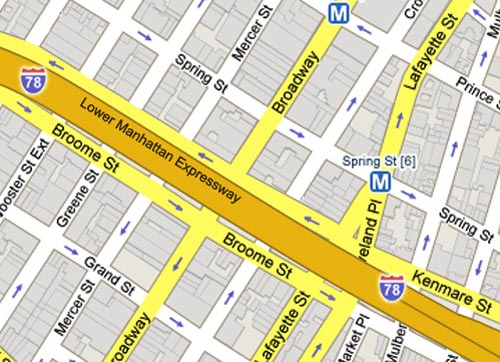Of Wrestling with Moses, the story of how Jane Jacobs took on Robert Moses and his plans for two Manhattan freeways, Tyler Cowen says:
The parts of this book about Jacobs are splendid. The parts about Moses are good, though they were more familiar to me. I believe there has otherwise never been much biographical material on Jacobs’s life.
The New York Times has a lengthy excerpt from the book that recalls Jacobs’ arrival in NYC.
Writing about the city remained her passion. She often went up to the rooftop of her apartment building and watched the garbage trucks as they made their way through the city streets, picking the sidewalks clean. She would think, “What a complicated great place this is, and all these pieces of it that make it work.” The more she investigated and explored neighborhoods, infrastructure, and business districts for her stories, the more she began to see the city as a living, breathing thing — complex, wondrous, and self-perpetuating.
The CBC has a clip of Jane Jacobs talking about Toronto and Montreal from 1969. In it, she makes the distinction between the two urban organizational forces at work in Toronto, a sort of “civil schizophrenia”: the vernacular spirit (“full of fun”) and the official spirit (“stamp out fun”). I also found a video on YouTube about Robert Moses and his difficulties with Ms. Jacobs which concludes with a cheeky update of Arnold Newman’s iconic photo of Moses.

The architect Robert Stern once remarked, “Can you imagine an elevated expressway at 30th Street just so Long Island guys could get to New Jersey?” Robert Moses could. A pair of Google Maps of Manhattan were redrawn to include the Lower Manhattan Expressway and Mid Manhattan Expressway, two highways masterminded by Moses that would have cut across Manhattan through Soho and at 30th St., respectively.

This was true for me, at least, while I was making these; Hand erasing buildings through SoHo, TriBeCa, and the LES was an eery experience as I tried to imagine what these places would really look like if my brush was a bulldozer.
More information on the Mid-Manhattan Expressway and the Lower Manhattan Expressway on NYCroads. (via migurski)
For decades, Robert Caro’s The Power Broker has been the definitive account of Robert Moses and how contemporary NYC got built. The portrait Caro painted of Moses was less than flattering. Now folks are thinking that, hey, maybe the guy wasn’t so bad after all. “That Moses was highhanded, racist and contemptuous of the poor draws no argument even from the most ardent revisionists. But his grand vision and iron will, they say, seeded New York with highways, parks, swimming pools and cultural halls, from the Belt Parkway to Lincoln Center, and thus allowed the modern city to flower.”







Stay Connected